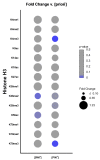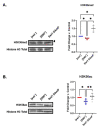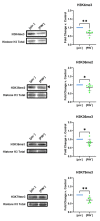[PRION+] States Are Associated with Specific Histone H3 Post-Translational Modification Changes
- PMID: 36558770
- PMCID: PMC9786042
- DOI: 10.3390/pathogens11121436
[PRION+] States Are Associated with Specific Histone H3 Post-Translational Modification Changes
Abstract
Prions are proteins able to take on alternative conformations and propagate them in a self-templating process. In Saccharomyces cerevisiae, prions enable heritable responses to environmental conditions through bet-hedging mechanisms. Hence, [PRION+] states may serve as an atypical form of epigenetic control, producing heritable phenotypic change via protein folding. However, the connections between prion states and the epigenome remain unknown. Do [PRION+] states link to canonical epigenetic channels, such as histone post-translational modifications? Here, we map out the histone H3 modification landscape in the context of the [SWI+] and [PIN+] prion states. [SWI+] is propagated by Swi1, a subunit of the SWI/SNF chromatin remodeling complex, while [PIN+] is propagated by Rnq1, a protein of unknown function. We find [SWI+] yeast display decreases in the levels of H3K36me2 and H3K56ac compared to [swi-] yeast. In contrast, decreases in H3K4me3, H3K36me2, H3K36me3 and H3K79me3 are connected to the [PIN+] state. Curing of the prion state by treatment with guanidine hydrochloride restored histone PTM to [prion-] state levels. We find histone PTMs in the [PRION+] state do not match those in loss-of-function models. Our findings shed light into the link between prion states and histone modifications, revealing novel insight into prion function in yeast.
Keywords: Saccharomyces cerevisiae; epigenetics; histone post-translational modifications; prion; protein aggregates; yeast.
Conflict of interest statement
The authors declare no conflict of interest.
Figures








Similar articles
-
Investigating the interactions of yeast prions: [SWI+], [PSI+], and [PIN+].Genetics. 2014 Jun;197(2):685-700. doi: 10.1534/genetics.114.163402. Epub 2014 Apr 11. Genetics. 2014. PMID: 24727082 Free PMC article.
-
Analysis of [SWI+ ] formation and propagation events.Mol Microbiol. 2017 Apr;104(1):105-124. doi: 10.1111/mmi.13616. Epub 2017 Jan 26. Mol Microbiol. 2017. PMID: 28035761 Free PMC article.
-
Analysis of Small Critical Regions of Swi1 Conferring Prion Formation, Maintenance, and Transmission.Mol Cell Biol. 2017 Sep 26;37(20):e00206-17. doi: 10.1128/MCB.00206-17. Print 2017 Oct 15. Mol Cell Biol. 2017. PMID: 28716950 Free PMC article.
-
New insights into prion biology from the novel [SWI+] system.Prion. 2008 Oct-Dec;2(4):141-4. doi: 10.4161/pri.2.4.8069. Prion. 2008. PMID: 19256027 Free PMC article. Review.
-
[PIN+]ing down the mechanism of prion appearance.FEMS Yeast Res. 2018 May 1;18(3):foy026. doi: 10.1093/femsyr/foy026. FEMS Yeast Res. 2018. PMID: 29718197 Free PMC article. Review.
Cited by
-
Direct and Indirect Protein Interactions Link FUS Aggregation to Histone Post-Translational Modification Dysregulation and Growth Suppression in an ALS/FTD Yeast Model.J Fungi (Basel). 2025 Jan 14;11(1):58. doi: 10.3390/jof11010058. J Fungi (Basel). 2025. PMID: 39852477 Free PMC article.
References
Grants and funding
LinkOut - more resources
Full Text Sources
Molecular Biology Databases
Miscellaneous

